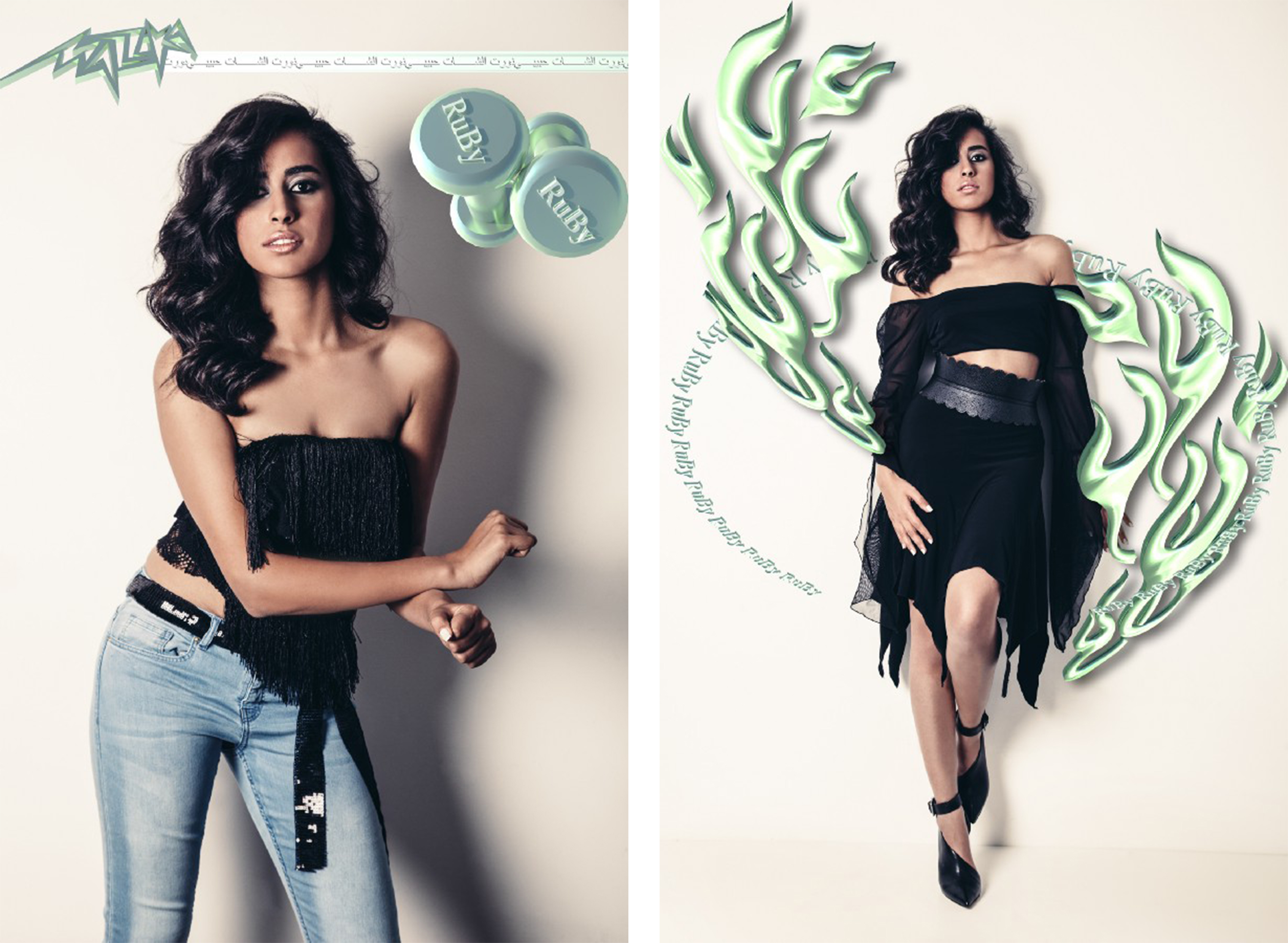Photographed by Amer Sweidan
Post production by Yazan el Zoubi
Makeup by Reem Jarhum
Hair by Nart Beauty Salon
Styled/designed by Fadi Zumot
Modeled by Razan
Creative direction by Khalid Abdel-Hadi
Sitting Editor Bethan Staton
By Dima Tannir
Ruby is the name of that deep red gemstone, but in the Middle East the name is associated with an Egyptian pop star, synonymous with scandal. The name was carefully chosen by the late cineaste Youssef Chahine for Ruby: the star who, like the gemstone, evokes sensuality and seduction.
Back in 2004, Ruby’s unapologetic appearance in music video “Leh Beydari Kidah?” fired up long debates. The controversial Sherif Sabri directed the clip, depicting Ruby as highly sexualized in comparison to the mostly modest Middle Eastern screen of the time. Full body shots of her moving her hips shifted to close ups of a seductive gaze while she works out on what resembles a gym pedal machine, flexing arms with a couple of dumbbells. Exposing the female body with an unashamed seductive stare prompted criticism across the Arab region. This was a rarity in Egypt, particularly after the returning wave of strict censorship on film and television during the 1990s and early 2000s. Ruby was frequently spoofed for the clip that symbolized sexuality on screen, and, more particularly, the craze for seductive video clips that had recently blossomed on Melody TV and Mazzika. The catcalling, voyeuristic Arab streets were not prepared.
In Techniques of the body, Marcel Mauss describes how he observed changes in the female gait on American streets, changes that, thanks to the influences of cinema, later spilled over to France. In a sense, Ruby symbolizes this new walk, the flirty pedal walk with the piercing gaze. It’s a portrayal that is created by the male gaze itself. The Ruby walk, however, doesn’t spill over to the streets: it remains confined to the flat screen. The streets, where modesty is controlled, diverge from the small screen and its brazen display of seduction.

images’ post production art works by Yazan el Zoubi. Right; Top, and belt, stylist’s own; were created and layered by the stylist. Jeans, H&;M. Look inspiration: Ruby’s ‘Ghawy’. Right, long sleeved chiffon crop-top and skirt, were created specifically for this shoot by the stylist/designer, Fadi zumot. Leather shoes and belt BCBG Max Azria. Look ‘inspiration: Ruby’s video ‘Kol Ma A’olloh Ah’
But on both streets and screens, bodies are something we’re intensely aware of. On the Arab street and on the television screen the importance of the body increases: one cannot avoid it or ignore it. In Ruby’s case, the body becomes a product of what is hidden on the streets: the street-body is divested of the screen-body, and the flesh concealed in the streets is flagrantly demonstrated on screen. The gaze diverted on the streets, too, is fixated towards the spectator when Ruby appears on screen. Abdel Wahab Elmessiri describes this as the dissociation of the video clip from political and social undercurrents. This divorce paves way for a discrepancy between what is tolerable on the streets and what is tolerable on the screen.
The French Nouvelle Vague director Jean-Luc Godard once said that “we look up at a cinema screen and look down at a television screen”. So as not to dwell on the difference between the cinema and the television screen, the part to retain here is “looking down”. Ruby is aware of this downward regard: she stares wilfully back at the voyeur enjoying her gyrating body, but also at the condescending observer, critical of Ruby’s unapologetic exposure. In a sense Ruby’s flatness, her confinement on screen, is her benediction. It would be difficult, on an Arab street, to expose one’s own body and return a fixed stare at the voyeur. On screen, the task becomes far easier and more effective.
Elmessiri calls it “horizontal dancing”. The body that belly dances classically is vertical but in video clips it is lying down, and one is titillated and seduced by the magic of the camera movements, the dizzying, dancing body. The camera “magic”, these acrobatics, pose another question. Who is the target audience? Who is Ruby’s gaze directed towards during the clip?
The creation of Arabsat and NileSat during the first few years of the 1990s, along with Orbit, Dream TV, Nile TV, ART and MBC, altered the cultural scene in the Arab world forever. From the 1990s to 2000s new cable channels like Melody TV, Mazzika and Rotana continuously emerged, broadcasting back-to-back music videos. That noughties video craze followed a cassette tape craze that had been a game-changer for the music industry during the 1970s, 1980s and 1990s. But the music video TV craze did something different: what it created was a new visual capital, in the economic sense, constructed from looping gazes that were returned to the spectator. This visual capital engaged audiences in a direct and continuous relationship with television celebrities and pop stars, which resulted in the emergence of a new “celebrity” capital, also in the economical sense, as celebrities visually entered the interior of households. It was a newly established affinity, and one Ruby flourished from. Aware of the gaze in her direction she returns it in acknowledgement of the newly intimate relationship and to confirm her star status. Her female gaze, returned to her audience, is justified.

images’ post production art works by Yazan el Zoubi. Top, Fruit Of The Loom. Skirt, Marks & Spencer. Strappy sandals, Trans-parents Italy. Look inspiration: Ruby’s video ‘Enta Aref Leih’.
If the Arab household’s new permanent guest is Ruby, then, who are her hosts? Couples, families, and young men and women in the Arab region became directly influenced by the new music video craze as it entered their fields of vision, and the effects created a moral panic.
Several articles during the early 2000s revealed a rise in divorce rates across the Arab world — and attributed it to a very particular cause. The reason, commentators argued, was Ruby, among other female stars of that era: Nancy Ajram, Elissa and Haifa Wehbe, to name a few. In an article in Al Arabiya in 2007, Dr. Azza Karim speculated about the relationship between married men’s exposure to TV pop stars in their home and compared those hyper-sexualized stars with “modest” wives. Such journalistic pieces should be taken with a dose of humor, but they illustrate the tension that the “new guest” in the household creates. Both men and women were influenced by new aesthetic and sexual standards of the female pop stars among them. For the male family members, Ruby becomes the virtually desired other. For females, she becomes their virtual mirror.
But is Ruby’s gaze defiant and liberating, empowering women across the Arab world to defy the other sex? Or does it simply defy tradition? Documentary filmmaker and researcher Hani Darwish puts fans of hyper-sexualized female pop stars in the same category as those who are infuriated by them: both, he says, “share a view of women that is stereotypical and degrading”.
On one hand, supporters promote an adaptation of occidental gender dynamics that disrupts the evolution of gender in the Arab world. On the other hand, critics of these sexualized stars promote a modern-yet-modest discourse rooted in Arab film of the 1950s and 1960s, and which has expired with the rise of satellite television. Ruby’s gaze grabbed the attention of both ends of the spectrum. Feminists also blamed Sherif Sabri for projecting women as consumerist products or worse, as “flesh”, and Ruby also took a hit from critics of her revealing attire and child/femme portrayal, especially in the clip “Leh Beydari kidah?”
“Ruby’s representation is a by-product of both her own interpretation and a director’s perception of female sexuality. It does not boil down to Ruby’s own free choice to celebrate her womanhood…”
Researcher Ouidyane Elouardaoui proposes that Ruby “exemplifies the trend that governs post-feminism”, the idea that women’s rights have been achieved and discussions about sexism and gender inequality are stale. He also suggests that sex appeal sways patriarchy, rather than being held accountable to it.
But Ruby’s representation is a by-product of both her own interpretation and a director’s perception of female sexuality. It does not boil down to Ruby’s own free choice to celebrate her womanhood. In this sense, Ruby as a figure requires a curiosity beyond the dialectic in her music videos. Standing at the center of the debate, she embodies more than her star status can carry. The censorship that followed filmed production in the 1980s was dismissed with the arrival of satellite TV, which also brought with it Ruby: a woman reestablishing a debate about sexuality and modesty that had been put to sleep with the death of Anwar Al-Sadat and the progressive return of Islamic figures into power in Egypt.

images’ post production art works by Yazan el Zoubi. Right: Top (and featured image), H&M. White sports pants, Adidas. Look inspiration: Ruby’s ‘Leih Beydary Keda’. Left: Orange tank-top and short-shorts, both sportswear from H&M. See-through and beige sandals, BCBG Max Azria. Leather jacket and bag, secondhand vintage. Look inspiration: Ruby’s video ‘Ana Omry Mastaneit Had’
In 2015, the debate over Ruby or her fellow female pop stars has diminished. El Mernissi claimed that these music videos were purely recreational, to distract the masses from current events. In present time, El Mernissi’s claim has also dissolved. 11 years on, the detraction and slander against Ruby has been utterly buried, with the exception of a few snippets about her in the press. The accomplishment of the Ruby music video craze is the vulgarization of the returned female gaze, the assertive female sexuality that was previously hidden in film and on TV for over two decades.
As the Ruby craze recedes into the past, one question becomes increasingly pertinent: when will this become a heated topic again? What Ruby daringly accomplished with much wit, can and should challenge again the status quo of gender dynamics and visual rhetoric in present Arab world.
Ruby’s music video craze divorced the flat screen from the streets until further notice. It raised eyebrows within the household and brought questions of gender dynamics outside an academic feminist discourse and into pop culture. As the streets and screens diverge further and construct their independent value systems, Ruby remains the instigator of a fearless gaze, returned to its sender, acknowledging it, and provoking it.

